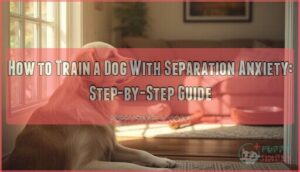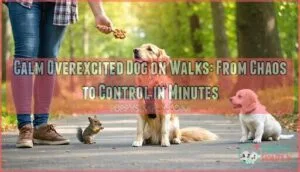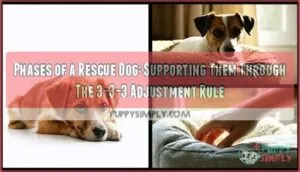This site is supported by our readers. We may earn a commission, at no cost to you, if you purchase through links.
Your dog’s frantic barking echoes through the hallway before you even close the door. Within minutes, neighbors report howling, and you return home to shredded cushions and scratch marks on the doorframe. This isn’t defiance or spite—it’s separation anxiety, and it affects nearly 14% of dogs, turning routine departures into genuine distress for both of you.
The good news? With the right dog training tips for separation anxiety, you can help your companion rebuild confidence and learn that your absence doesn’t mean abandonment. The process requires patience and specific techniques, but countless dogs have transformed from anxious shadows into calm, independent pets who trust you’ll always return.
Table Of Contents
- Key Takeaways
- Recognizing Separation Anxiety in Dogs
- Key Causes of Separation Anxiety
- Essential Training Principles
- Effective Desensitization Techniques
- Managing and Preventing Anxiety
- Tools and Aids for Anxiety Relief
- Frequently Asked Questions (FAQs)
- How to break a dog from separation anxiety?
- Can a dog be trained out of separation anxiety?
- What is the best treatment for dogs with separation anxiety?
- Is dog separation anxiety curable?
- How can I help my dog feel less anxious during my absence?
- What are some effective calming techniques to use before departures?
- How long does it typically take to resolve separation anxiety?
- Can medications be used to manage separation anxiety in dogs?
- What are the signs that my dogs anxiety is improving?
- Can I adopt another dog to reduce separation anxiety?
- Conclusion
Key Takeaways
- Separation anxiety affects about 14% of dogs and shows through specific distress behaviors like destructive chewing, excessive vocalization, and escape attempts that occur only when left alone—not general misbehavior.
- Gradual desensitization starting with 1-2 minute departures and slowly increasing time over weeks, paired with positive reinforcement and desensitizing pre-departure cues like grabbing keys, forms the cornerstone of effective treatment.
- Creating a predictable routine with consistent departure and return times, establishing a safe space with familiar comfort items, and using interactive puzzle toys helps reduce anxiety triggers and builds your dog’s independence.
- Most dogs show meaningful improvement within 4-6 months of consistent behavior modification, though severe cases may need veterinary-prescribed medication alongside training and can take 6-12 months of dedicated work.
Recognizing Separation Anxiety in Dogs
Your dog isn’t acting out to punish you—they’re genuinely struggling when you leave. Separation anxiety looks different from normal bad behavior, and knowing what to watch for can help you step in early. Let’s break down the behavioral, physical, and situational signs that signal your dog needs help.
Your dog’s distress when you leave isn’t spite—it’s separation anxiety, and recognizing the signs early helps you intervene before panic takes hold
Common Behavioral Symptoms
Distress signals reveal themselves clearly when your dog experiences separation anxiety. Watch for these behavioral issues that indicate panic symptoms and the need for dog behavior modification:
- Repeated vocalizations such as whining or barking when you’re away
- Destructive chewing or digging that occurs only when left alone
- Pacing, restlessness, or panting during periods of separation
- Excessive salivation or drooling observed before or after departures
- Attempts to escape from the home or crate when anticipating departure or during absence
These anxiety signs distinguish canine behavioral health concerns from simple misbehavior, signaling true separation stress requiring your attention. Understanding clear science writing is essential for effectively communicating research on separation anxiety.
Physical Signs of Anxiety
Beyond vocalizations and destructive behaviors, your dog’s body reveals critical physical cues of canine stress. Elevated heart rate, labored breathing, and dilated pupils signal anxiety disorders taking hold.
You’ll notice trembling limbs, excessive panting without exertion, and increased drooling—all anxiety symptoms indicating panic-level distress. These physical manifestations of dog separation anxiety demand immediate attention through proper canine behavioral health intervention and dog behavior modification strategies.
Addressing these issues requires understanding research methodology to develop effective solutions.
Distinguishing Anxiety From Other Issues
Not every anxious behavior signals true separation anxiety. Medical evaluation should rule out pain or illness mimicking stress signals first.
Watch for behavioral patterns tied specifically to your departures—does distress fade when you return? Document timing and emotional triggers carefully.
Anxiety diagnosis requires distinguishing separation anxiety from routine boredom or fear-based responses. Canine behavior specialists use these distinctions to design effective behavioral therapy targeting actual anxiety disorders.
Key Causes of Separation Anxiety
Understanding what triggers separation anxiety is the first step toward helping your dog feel secure when you’re away. Some causes stem from past experiences or sudden changes, while others are tied to your dog’s natural temperament or the way you interact with them.
Let’s look at the three main factors that contribute to this challenging condition.
Life Changes and Triggers
Your dog’s world gets turned upside down when life brings sudden changes—moving homes, schedule changes, or new family dynamics can all trigger separation anxiety. Relocation stress alone raises cortisol levels for weeks. I’ve seen dogs perfectly content one month suddenly pacing the next after a move.
These trigger events demand gradual desensitization and careful attention to predeparture cues before your dog crosses the threshold into full panic.
Breed and Personality Factors
Some dogs carry genetic predispositions that make separation anxiety more likely—herding and working breeds often show higher baseline anxiety thresholds in veterinary assessments. Your dog’s canine temperament matters too. Shy personality types exhibit more pronounced stress responses than bold dogs when left alone.
- Breed traits: Certain breeds carry genetic markers linked to stress reactivity
- Anxiety thresholds: Individual variation means training must match your dog’s unique temperament
- Noise sensitivity: Dogs predisposed to sound phobias often experience amplified separation distress
- Temperament testing: A Certified Separation Anxiety Trainer can assess your dog’s specific anxiety profile
Owner Behavior Influences
Surprisingly, your actions shape your dog’s emotional responses more than you might think. Speaking in a calm, positive tone before leaving reduces arousal levels, while consistent routines help your dog predict departures without panic.
Owner cues matter—when you reward calm behavior after returning, you’re building emotional support through positive reinforcement.
Calm departures paired with consistent routines offer pet owners essential dog owner guidance for lasting results.
Essential Training Principles
Before you jump into specific training techniques, you need to understand the foundation that makes any separation anxiety program work. Think of these principles as the bedrock—without them, even the best exercises will fall short.
Let’s cover the three core elements that will guide every step of your dog’s recovery journey.
Importance of Patience and Consistency
Training a dog with separation anxiety isn’t a sprint—it’s a marathon that rewards patient owners who stick with consistent training. Your dog needs time to rewire fear responses, and rushing the process often leads to setbacks that undo weeks of progress.
- Consistent routine and calm environments reduce confusion and help your dog predict what happens next
- Gradual departures with positive reinforcement build trust without triggering panic-like stress responses
- Relaxation techniques paired with dog training techniques create lasting dog separation anxiety solutions through gradual progress
Setting Realistic Training Goals
How do you measure success when every dog learns at a different pace? Goal setting strategies for separation anxiety should start with a baseline assessment—record your dog’s current tolerance before you leave.
Training schedules need realistic expectations, with checkpoint planning that reflects gradual desensitization over weeks, not days.
Progress tracking through video logs helps you adjust training methods for anxiety as needed, ensuring dog separation anxiety solutions match your pet’s actual capabilities.
Establishing a Supportive Environment
Your dog can’t heal in the same environment that’s making them anxious. Before starting gradual desensitization, you need to redesign their physical space and daily rhythm.
- Predictable routines minimize the threshold for anxiety triggers, giving your dog emotional support through consistency
- Safe spaces with calming techniques (familiar scents, soft bedding) provide environmental enrichment during your absence
- Neutral departures prevent dramatic goodbyes that spike separation anxiety during dog training sessions
This foundational pet owner guidance sets the stage for success.
Effective Desensitization Techniques
Desensitization is the cornerstone of treating separation anxiety, helping your dog gradually understand that being alone isn’t something to fear. This process works by systematically exposing your dog to departures in small, manageable doses that don’t trigger a panic response.
The following techniques will guide you through building your dog’s confidence and independence at a pace that respects their emotional limits.
Gradual Departure Exercises
You’ll build your dog’s confidence through systematic separation training that starts small and progresses slowly. Begin with 1–2 minute departures, then gradually increase by 2–3 minutes over several weeks.
This desensitization approach addresses anxiety triggers head-on while teaching your dog that you always return. Pair each departure with high-value treats when you come back, reinforcing calm behavior and turning departures into positive experiences.
Desensitizing Predeparture Cues
Your keys, shoes, and coat often send a clear message: you’re leaving. These predeparture cues can trigger anxiety long before you walk out the door. Start desensitization techniques by performing these actions without actually departing—pick up your keys, then sit down. Pair cue exposure with treats to help your dog stay calm. Gradually separate the signal from the departure itself:
- Present cues while remaining home, rewarding relaxed behavior
- Practice brief absences only after anxiety thresholds stay low
- Maintain calm environments during all training sessions
- Use short daily sessions to prevent overwhelming your dog
This counterconditioning approach rewires your dog’s emotional response to separation anxiety triggers.
Counterconditioning Strategies
Beyond simply removing the predeparture cues, counterconditioning rebuilds your dog’s emotional response through trigger exposure paired with high-value treats. When your dog stays calm near anxiety-inducing signals, introduce safety signals—like a consistent marker word—to reinforce relaxation.
These calming techniques transform separation anxiety into positive associations, making behavior modification stick. Desensitization methods work best when rewards outnumber triggers during every training session.
Managing and Preventing Anxiety
Once you’ve worked through desensitization exercises, it’s time to build a foundation that keeps anxiety from creeping back in.
The right environment and daily habits can make all the difference in helping your dog feel secure when you’re away.
Let’s look at three practical strategies that work together to create lasting calm.
Creating a Safe Space
Your dog’s comfort zone starts with the right environment. A quiet retreat—whether it’s a spare room or a corner with soft bedding—gives your anxious pup a secure area where they can decompress. This dedicated space reduces stimuli and teaches them that being alone doesn’t mean being unsafe.
- Include familiar comfort items like a worn t-shirt or favorite blanket
- Keep water accessible and guarantee proper ventilation
- Let your dog access the space during calm times, not just departures
- Maintain consistent boundaries so the safe room becomes predictable
Utilizing Crate Training
When paired with a safe space, crate training for separation anxiety offers structured comfort your anxious dog craves. Choose a crate size that allows standing, turning, and lying down without crouching—too large undermines the purpose, too small causes distress.
Start crate introduction with positive associations—toss treats inside, add favorite toys, never force entry. Gradually extend crate time as your dog remains calm, building from minutes to longer stretches. Pair crate placement with predictable activities like mealtimes to establish routine. This puppy training foundation teaches your dog that crate comfort equals security, not punishment, making it a powerful dog training tool against separation anxiety symptoms.
| Training Phase | Duration | Key Actions |
|---|---|---|
| Introduction | 2-3 days | Place treats inside; leave door open |
| Short Sessions | 5-10 minutes | Close door while you’re home |
| Extended Time | 15-30 minutes | Step outside briefly; return calmly |
| Routine Integration | Ongoing | Use for meals, naps, quiet time |
Promoting Independence and Routine
Consistently, Daily Schedules with fixed meal and walk times anchor your dog’s sense of security, reducing separation anxiety by replacing unpredictability with calm structure. Independence Training starts with gradual departures—leave for 30 seconds, return neutrally, repeat. Environmental Enrichment through puzzle toys occupies anxious minds, while Routine Tracking reveals which Calming Exercises work best. This consistent routine transforms panic into trust through patient, methodical dog training.
Tools and Aids for Anxiety Relief
While training and routine form the foundation of your approach, the right tools can make a real difference in helping your dog feel calm and secure.
From engaging toys to technology that keeps you connected, these aids work best when paired with consistent behavior modification.
Let’s explore practical options that can support your dog during alone time.
Interactive Toys and Puzzles
Interactive toys and puzzles offer powerful calming aids for managing separation anxiety in your dog. These engagement tools provide essential dog mental stimulation that reduces stress behaviors during alone time.
- Treat dispensing puzzles encourage problem-solving while extending calm periods during your departures
- Rotating toy types maintains novelty and prevents boredom, supporting long-term anxiety management in dogs
- Supervised interactive play helps reinforce relaxed behavior, building positive associations with independence
Match puzzle difficulty to your dog’s abilities to avoid frustration.
Monitoring With Security Cameras
By installing cameras with motion detection and real-time alerts, you’ll gain objective insights into your dog’s separation anxiety patterns. Strategic camera placement near entrances and key stress zones captures pacing, vocalization, and destruction attempts.
Video analysis helps you timestamp anxiety behaviors and adjust desensitization steps accordingly. Just remember data privacy practices—secure storage protects your household while you track your dog’s training progress.
When to Consider Medication or Supplements
Sometimes behavioral training hits a wall, and that’s when anxiety medication or supplements step onto the stage. Consider pharmacological support if:
- Your veterinarian or veterinary behaviorist confirms moderate to severe separation anxiety after ruling out medical causes
- Behavior modification alone hasn’t reduced anxiety disorders within 4-6 weeks
- Your dog’s panic prevents any training progress
- Supplement efficacy requires professional veterinary guidance for dosage management
- Treatment duration needs regular monitoring and adjustment
Medication options like SSRIs work alongside—not instead of—your dog separation anxiety treatment plan.
Frequently Asked Questions (FAQs)
How to break a dog from separation anxiety?
Breaking separation anxiety requires behavior modification through gradual desensitization. Start with 1-2 minute absences, pair departures with positive reinforcement, and desensitize anxiety triggers.
Create calming techniques that promote dog relaxation during separation strategies.
Can a dog be trained out of separation anxiety?
Yes, most dogs can improve markedly through behavior modification and positive reinforcement.
Studies show a 40–60% reduction in anxiety behaviors over 6–12 weeks with consistent desensitization protocols guided by a certified separation anxiety trainer.
What is the best treatment for dogs with separation anxiety?
The best treatment combines behavior modification with veterinary-prescribed medication for moderate to severe cases.
Gradual desensitization, consistent routines, and professional guidance create thorough treatment plans that reduce anxiety-related behaviors within 4–6 weeks.
Is dog separation anxiety curable?
Complete separation anxiety cure isn’t guaranteed for every dog, but certified separation anxiety trainers report significant symptom management and long-term relief through consistent anxiety treatment.
This turns a chronic recovery process into meaningful improvement.
How can I help my dog feel less anxious during my absence?
Treating separation anxiety starts with gradual desensitization to absence preparation and departure strategies. Establish calming signals, create predictable routines, and use relaxation techniques to reduce dog anxiety triggers. Consistency transforms how your dog experiences owner departure.
What are some effective calming techniques to use before departures?
Before leaving, establish a predictable 2–5 minute calming routine with low-energy interaction and a puzzle toy. Pair this with soft music, dim lighting, and a neutral verbal cue to create positive associations with your departure.
How long does it typically take to resolve separation anxiety?
Most dogs show meaningful progress in 4 to 6 months with consistent dog behavior modification, though severe cases may require 6 to 12 months of dedicated work reducing dog anxiety through structured desensitization.
Can medications be used to manage separation anxiety in dogs?
Yes, anxiety medication like fluoxetine or clomipramine can support behavioral therapy when prescribed by your vet. These drug therapy options provide anxiety relief during training, but they’re most effective combined with consistent treatment plans and veterinary guidance.
What are the signs that my dogs anxiety is improving?
Like watching storm clouds clear, you’ll notice anxiety reduction through calm behaviors: less whining, improved sleep patterns, reduced pacing, and increased confidence.
Monitor progress carefully—these behavioral modification milestones confirm your separation anxiety training is working.
Can I adopt another dog to reduce separation anxiety?
A second dog can reduce visible anxiety in some cases, but outcomes vary widely.
Consult a dog behaviorist first—poor matches may worsen stress, and separation anxiety often requires targeted behavior modification beyond adding companion animals.
Conclusion
Consider Bella, a rescue Lab who once demolished three doors in panic—now she naps peacefully through eight-hour workdays. Her transformation wasn’t magic; it took six weeks of consistent desensitization and counterconditioning.
Your journey with these dog training tips for separation anxiety may follow a different timeline, but the destination remains the same: a confident companion who knows your departures are temporary, and your return is certain. Start tomorrow’s first practice session today.
- https://www.aspca.org/pet-care/dog-care/common-dog-behavior-issues/separation-anxiety
- https://www.petmd.com/dog/training/how-help-dog-separation-anxiety
- https://www.rover.com/ca/blog/heres-real-way-train-dog-separation-anxiety
- https://www.thinkjinx.com/blogs/news/dog-separation-anxiety-training
- https://www.bestlife4pets.com/blogs/pet-blog-tips/dog-separation-anxiety-training














